Samsung HW-MS650 is a large soundbar without a separate wireless subwoofer, but with a burly built-in woofer.
Samsung HW-MS650: no subwoofer
The HW-MS650 is a brand new soundbar from Samsung. It is a member of the Sound + Premium family that was presented at CES in January 2017. As the name suggests, Samsung sees this device as a ‘better’ soundbar, despite the absence of a wireless subwoofer. That goes against the flow, because until recently, soundbars without a separate sub were rather cheap models and you just paid more for one with a wireless subwoofer. The idea behind this is that a classic, sleek soundbar can only contain smaller drivers or speakers that are not capable of reproducing very low tones. And as everyone knows who ever watched a movie from the Marvel Cinematic Universe: without a solid layer of bass, an action film is just a faint job.
But Samsung sees it differently, just like Bose and Q Acoustic. Both Bose (with the SoundTouch 300) and Q Acoustic (with the M3) claim to be able to deliver a convincing home theater experience with one device. It is also no secret that Samsung and co choose this strategy because the Sonos Playbar has had a huge success. The Playbar comes standard without a subwoofer and still costs 799 euros (you can extend it with a Sonos Sub for another amount), which is a nice sum for a soundbar. The HW-MS650 can be expanded with additional rear speakers, just like the Playbar, giving you a real surround experience. The soundbar can process Dolby 5.1, so you really get to hear surround. However, we have not been able to test this, due to the lack of additional speakers.
Samsung HW-MS650: rectangular design
In contrast to many recent soundbars, the HW-MS650 is not a sleek soundbar. On the contrary, it is a fairly large rectangle of 106 cm wide, 13 cm deep and 7.8 cm high. That’s a size that fits nicely with our 55-inch TV set, with a 40-inch TV the soundbar will appear wider.
The choice for a larger housing is not that strange, because the soundbar also has to produce low tones. And that requires a large housing. The HW-MS650 also has a lot of speakers: nine pieces. And they are certainly not all tiny tweeters, as we often saw with very slim sound bars. There are three of those small tweeters, in addition to six larger speakers with an oval, so-called ‘racetrack’ shape. This shape creates a broad appearance in the horizontal plane, which is good news if you look with the whole family.
The dark gray HW-MS650 (or the technically identical silver-gray HW-MS651) will not win beauty prizes or be described as a design icon, but its functional design is also not outrageous or kitsch. Put the soundbar on your TV cabinet and it will not go into your interior, which some people might not like. At the same time, there are no noticeable lines, displays or LED lights, so that it does not radiate too much ‘tech’ feeling.
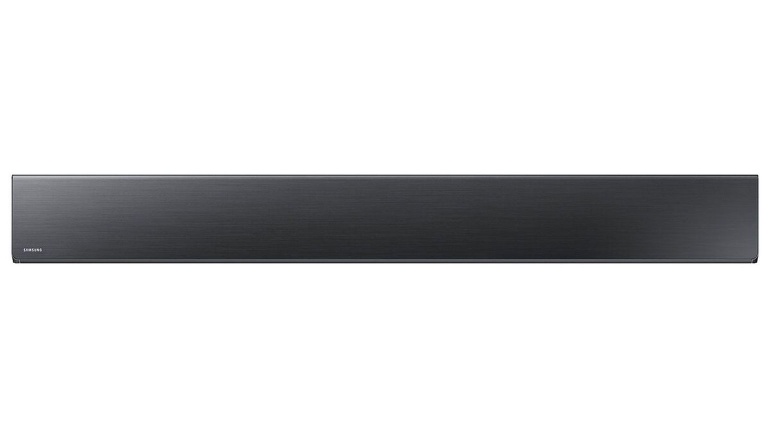
The HW-MS650 is very striking if you hang it on the wall, which is possible with the included brackets. Unlike the Playbar, for example, you can not tilt this soundbar when hanging 90 degrees. It hangs in the same orientation as it is on your TV stand, which means that the soundbar protrudes almost 8 cm from the wall surface. That can be a strong contrast to a television screen that you just as flat against the wall as possible. Well, this way of hanging up is something we see more recently because there are more and more soundbars with drivers in front and at the top (for Dolby Atmos). With the HW-MS650 there is no question of Dolby Atmos and all drivers are directed to the front. The similar but slightly more expensive HW-MS750 has two additional speakers at the top. You also encounter the HW-MS6500 on the market. This is the curved version of the HW-MS650.
For comparison: at the Sonos Playbar the speakers are placed internally at an angle of 45 degrees. Whether you place the Sonos soundbar on a TV cabinet or tilt it 90 degrees against the wall, they always radiate towards the listener.
Samsung HW-MS650: connect
The number of connections shows that the HW-MS650 is still a middle class. You will not find a complete collection of HDMI inputs for video sources such as with more expensive sound bars. There is only one, plus an ARC-compatible HDMI output that connects you to the television. You can use the digital optical input as an alternative to the TV connection or for a music source, such as a CD player. Finally, there is an analogue auxiliary input for music players and other music devices.
This means that not all options are listed yet. Bluetooth is of course also present, because that can no longer be lacking at this price point. But even more interesting is that the HW-MS650 connects via WiFi to Samsung’s Multiroom platform. This allows you to stream music via an app (iOS or Android) to the soundbar, both your own files and via streaming services. It is also possible to combine the HW-MS650 with other wireless speakers from Samsung.
All connections are placed at the bottom of the device, in a spacious niche. We are happy to see that there is enough space for larger HDMI plugs and all possible cables. The recently tested Philips Fidelio B8 is a nice proof that this can still be a problem. But not with this Samsung. Because of the larger recess at the back it is possible to neatly remove all cables.
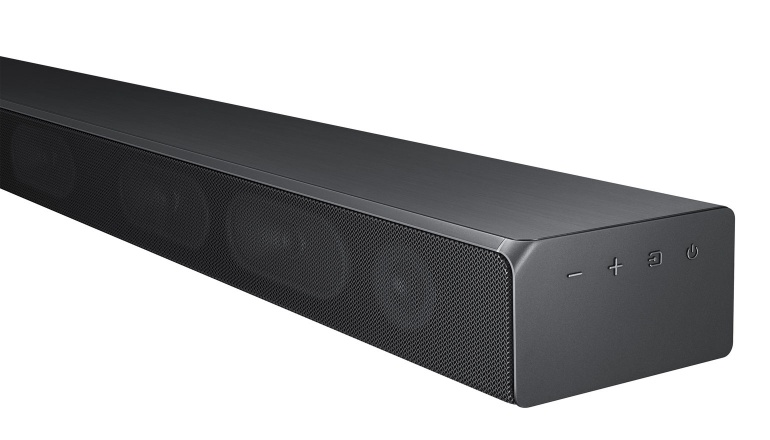
Very special is that the HW-MS650 is provided to loop power to a TV. This seems particularly useful if you hang the soundbar on the wall and only use one power cord. You can then supply the TV via the soundbar with a supplied cable. Samsung sells a special bracket (the WMN300SB) which makes it very easy to connect the HW-MS650 to a wall-mounted TV, without having to drill additional holes.
Do you have a recent Samsung TV? Then you can also wirelessly establish an audio connection between the HW-MS650 and the TV set. Samsung shows that this is something unique for their televisions, but in principle you can realize a wireless connection via Bluetooth with many other new TVs. Yet we continue to advise HDMI. It is more reliable and sounds better.
Samsung HW-MS650: operation
If you connect the HW-MS650 via HDMI, you can simply use the TV remote control to adjust the volume. Keep the compact remote of the soundbar at hand, because here are a few additional features that you might find useful. This way you can switch between different sound modes via Sound Mode. The Smart option searches for itself, but we still found it necessary to switch to Music manually if we streamed some tracks. The sound modes have a noticeable impact, yet experimenting is a good idea. The same advice applies to the Bass tuning: try it out. We chose +1 in our room of twenty square meters.
When trying the remote you may notice the display for the first time. The HW-MS650 certainly has one, but usually it is not to distract you from watching TV. As with the previous generation of sound bars of the Koreans, Samsung is looking for a white OLED display that is hidden behind a grille. But where the display in previous models was quite large and was mounted centrally, the screen at the HW-MS650 is at the far right and is rather narrow. It’s a bit strange at first, but it works fine. Samsung probably chose this placement so that there is more room for a central speaker setup (see later in this article).
On the right side of the soundbar there are also a number of discrete keys, including the volume keys and the input selection. It is just like the buttons on the side or back of TVs: you may never use them, but they are useful if the small remote has disappeared between the cushions of the couch.
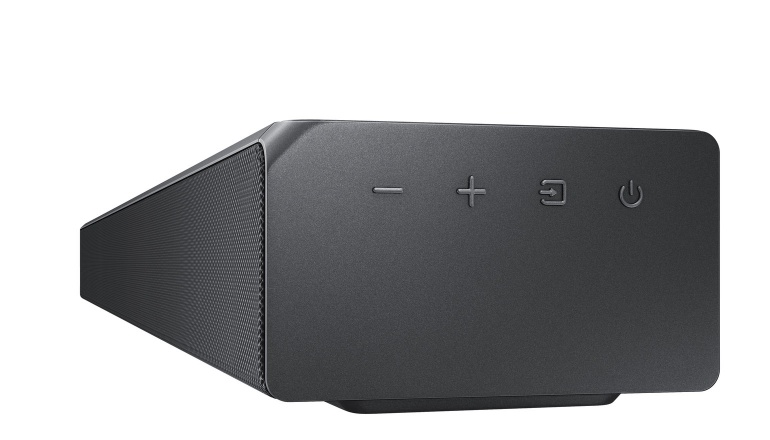
Samsung HW-MS650: streaming and multiroom
The big competitor for the HW-MS650 is the Sonos Playbar, a device that is much more than a solution for TV sound. It is almost as focused on streaming music. However, the Samsung HW-MS650 does not lag behind in that area. It works with many other Samsung devices that are multi-room compatible. Multiroom is a very broad concept at Samsung, a function that is present on their smart TVs, Blu-ray players and soundbars.
You may not have another Samsung product in your home? No problem, ignore the multiroom data and view it as a very complete streaming solution. Because that’s it too.
You control the soundbar via the Multiroom app. Samsung is now ready for its third, completely revised version of the app. Although we did not think the second generation app was bad, this is clearly a case of three times the law. The new version of the Multiroom app is inspired by Tizen, the smart TV interface of the Samsung televisions. As with Tizen, the app shows all streaming services and music sources on the network (DLNA shares) as icons in one screen-wide horizontal row, which is very useful. The only downside is that you can not remove unused services and network shares from the bar, although you can drag the active services to the beginning of the row.
Below the row of icons appear criteria with which you can search through music of the chosen service or source: Albums, Artists, Genres, and so on. There is a lot of white space on the screen and the functions are all large, so the app looks modern and you can also hit things accurately.
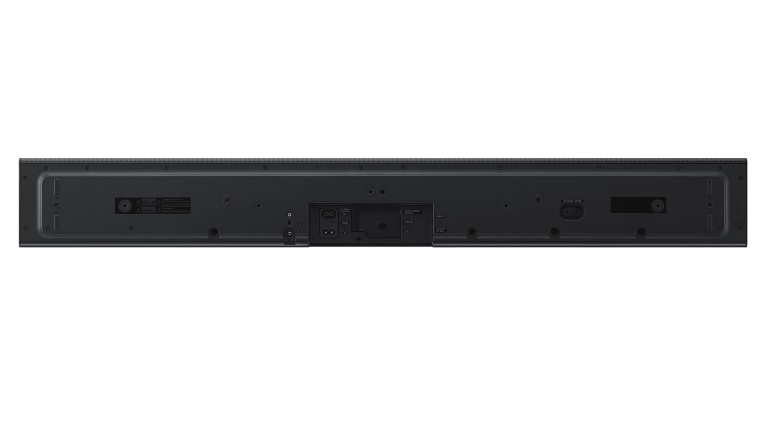
Samsung introduces a powerful search function in the new Multiroom app, which allows you to search for all the services you have subscribed to. If you have a subscription to Deezer and Qobuz, for example, you will get search results for both services. Of all providers of multiroom systems only Sonos and now Samsung have this powerful ‘universal’ search function. One minus point at Samsung: Spotify is implemented via Spotify Connect, which means that you step out of the Multiroom app for that service and work via your own Spotify app. This is not that bad in itself, since multiroom in Spotify Connect is exceptionally well supported with Samsung products. But the search function can therefore not display results from Spotify. Whether that is a problem depends on which services you all use. A plus at Samsung is that you can also stream CDs elsewhere in the house. For example, we have a Samsung UHD player in the test room. It automatically appears in the app as a source for music. So you can select and stream a music CD.
It is an observation that we often make with apps for multiroom systems: you use them better via a tablet. The Samsung Multiroom app works well on a smartphone because of its spacious interface, but on a tablet it is much nicer. If a track already plays and you keep the tablet in landscape orientation, the screen is neatly shared between a large image of the current song plus the necessary media controls and the main screen on which you select services and music. If you turn the tablet to an upright position, the album cover that is played will fill the entire screen.
Samsung HW-MS650: smooth installation
The app is provided to help you log in the soundbar on the network. If you only use HW-MS650 for your TV, then of course you do not have to. But the streaming functions are fun and a lot of work is not. The installation procedure is entirely in line with the clear interface with large elements. If you have to choose which device you want to connect to the network, then you should not, for example, choose an obscure model number from a list. The app shows large images of relevant Samsung devices. Handy for non-techies, it seems to us. Logging into the Wi-Fi network is done in a few steps, because the app first searches via Bluetooth with the soundbar. The setup can therefore be called one of the easiest on the market. The only clumsiness on the Samsung HW-MS650: you have to press a button at the bottom of the soundbar when installing. If you have just neatly built it into a piece of furniture, that is a bit tricky.
In fact, the app can almost completely replace the physical remote, only you have to dig deeper for certain things. You can select inputs (for example if you want to switch to the TV decoder connected to the HDMI input), but you must first click on Settings. It might have been a good idea, just as with Tizen, to simply put all the entrances in the service bar with services. Alarms and sleep timers can be set via the app, but the sound modes are not. That is why we also say that the app can almost replace the remote.

Samsung HW-MS650: comparison
And what if we compare the Samsung HW-MS650 with the Sonos Playbar, which is also installed in the test room? The Samsung soundbar is undoubtedly the more spectacular sounding of the two, especially if you raise the bass level a bit higher. He dives deeper and more powerful, albeit slightly more woolly. But with films that is allowed. The separate center channel is very effective, allowing the Samsung HW-MS650 dialogues to release well from surround effects. That is slightly less the case at the Playbar.
To compare TV performance, we watched film material via the Netflix app on our smart TV. The Playbar was connected to the television via optical cable, the Samsung via HDMI (sound mode to ‘Movie’, Surround to ‘On’). It became possible to perform live A / B testing, including with ‘Ender’s Game’ and the great ‘Stranger Things’. What immediately strikes you when you switch between the two is that the Samsung presents dialogues very prominently despite a slightly dull character. Even in scenes with deep tones, such as in the beginning of Stranger Things, when the scientist and Will Byers are attacked by a mysterious creature, you jump out of your seat faster at the Samsung. The broader soundstage and the heavier basses make the films and TV series simply come to life.
The Sonos soundbar, however, has its points on which it scores better. If you hang it, it is a slimmer appearance. In addition, the Playbar is less wide, which visually slightly better with smaller TVs.
We also find the musical presentation of the Playbar (since a recent firmware update) a bit fresher and clearer. We noticed that in piano playing, for example with the new album by Marialy Pachecho (lossless streamed, via Qobuz). The track ‘Burundanga’ is a good one to test with: first slow and dark, then frisky and higher. If we compare the piano sounds a bit more important with the Samsung, but the high details are just a bit more artificial than with the Playbar. Switching the Samsung HW-MS650 to music mode helps, but not entirely. We are talking about a difference at the level of detail that you will notice especially in an A / B comparison. We jump back twenty (20!) Years back in time, to ‘Leave Home’ by The Chemical Brothers, to hear how the two rivals are doing in terms of reproducing electronic music. First and foremost: punishment how the Samsung HW-MS650 can play extremely loud and keep it all under control, without hoping for distortion. At the Playbar you reach the limits faster, but we talk about volumes where there is a chance that a strict policeman will ask you to take it easy.
In short, on a musical level, the Playbar does better because of its better detail and dynamic power, but the HW-MS650 is a lot more serious in terms of bass. And he is not afraid of high volumes. This makes the Samsung perhaps better suited for a party to start. The less sharp reproduction coupled with the bass makes the Samsung soundbar also deliver a higher fun factor for EDM and rock.
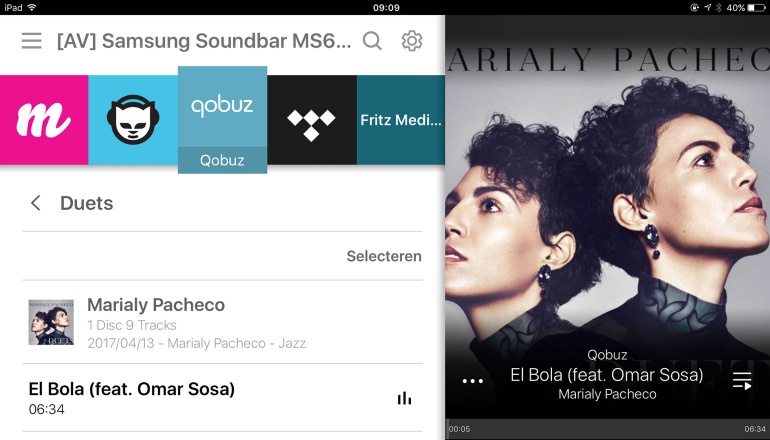
Recently we also visited the Q Acoustics M3. In terms of detailed bass reproduction that British soundbar scores better than the Samsung, but it lacks the unobtrusive design and support for streaming services.
Samsung HW-MS650: conclusion
The Samsung HW-MS650 is a great solution for those who want a much better TV sound in a relatively minimalistic package. Relatively, because the soundbar itself is still quite large. But you do not have to install a wireless subwoofer, while the Samsung HW-MS650 is capable of producing decent sound. Especially in combination with a Samsung TV, you also have interesting options, such as the seamless bracket, wireless connection and the looping through of power.
The Samsung HW-MS650 is a great soundbar to take a movie night to a higher level. On a musical level, it is rather a middle class in terms of performance – which may be less of a problem if you listen to pop and electronics – but it does have very good streaming and multiroom capabilities. The big rival is without a doubt the Sonos Playbar, but it costs a few hundred euros more and is not superior in all respects.

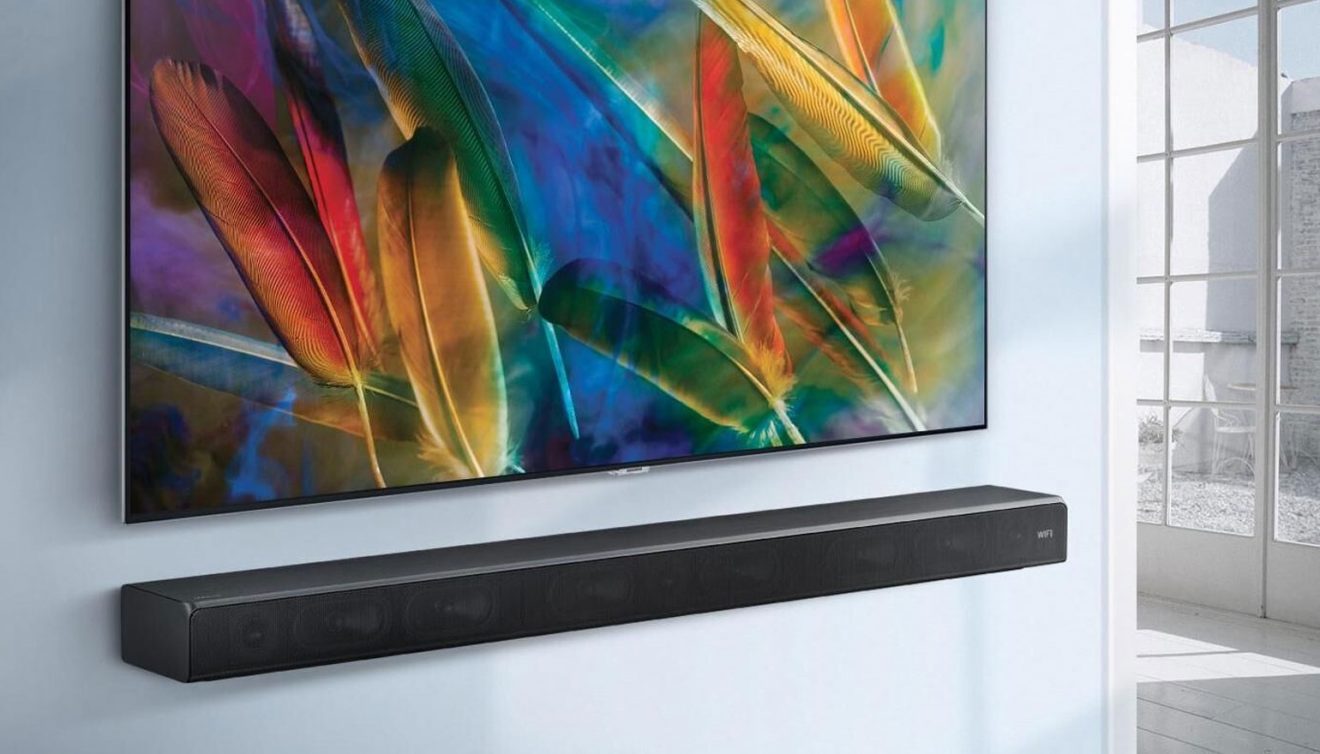

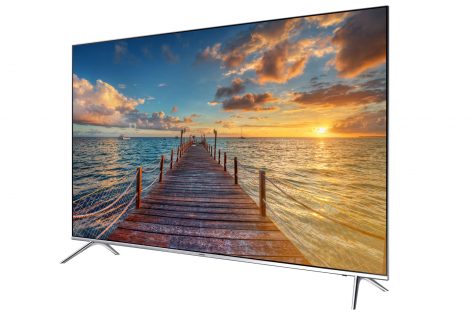
Add Comment